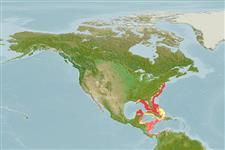>
Ophidiiformes (Cusk eels) >
Ophidiidae (Cusk-eels) > Ophidiinae
Etymology: Lepophidium: Latin, lepus, leporis = rabbit + Greek, ophis = serpent (Ref. 45335).
More on author: Gill.
Issue
Most references to L. profundorum between 1950 and 1986 apply to L. brevibarbe.
Environment: milieu / climate zone / depth range / distribution range
Ecologie
marien demersaal; diepte 29 - 399 m (Ref. 91765), usually 60 - 399 m (Ref. 91765). Tropical; 46°N - 21°S, 90°W - 73°W (Ref. 91765)
Western Atlantic: Georges Bank, Canada to the Florida Keys and the northern and eastern Gulf of Mexico.
Grootte / Gewicht / Leeftijd
Maturity: Lm ? range ? - ? cm
Max length : 28.0 cm TL mannelijk / geslacht onbekend; (Ref. 49746); common length : 22.0 cm TL mannelijk / geslacht onbekend; (Ref. 5217)
Korte beschrijving
Determinatiesleutels | Morfologie | Morfometrie
Dorsale stekels (totaal) : 0; Dorsale zachte stralen (totaal) : 129 - 142; Anale stekels: 0; Anale zachte stralen: 109 - 121; Wervels: 73 - 78. This species possess the following characters: usually with 15 precaudal, 58-59 caudal, and 74-76 total vertebral counts; number of fin rays usually in dorsal 131-137, anal 112-117, pectoral 21-23; pyloric caeca 3 (2-4) in tiers of 2-3 caeca in the first and one in the second; total gill rakers on first arch 9-11 (8-13). Colour of head and body tan to brown, belly whitish; a conspicuous and diagnostic series of 14-23 pale spots, which are slightly smaller than the eye but larger than the pupil, extending from just behind the opercle to the caudal-fin base; a second series of smaller pale spots running along the anterior part of the body just below the dorsal-fin base (spots largely disappear in old museum specimens); dorsal and anal fins dark-edged posteriorly; gill chamber, gill bars, esophagus and the roof of the mouth behind the vomer and between the palatines blackish; stomach and hindgut unpigmented (Ref. 91765).
Uncommon species (Ref. 34024). Oviparous, with oval pelagic eggs floating in a gelatinous mass (Ref. 205).
Levenscyclus en paargedrag
Maturities | Voortplanting | Spawnings | Egg(s) | Fecundities | Larven
Robins, C.R., R.H. Robins and M.E. Brown, 2012. A revision of Lepophidium (Teleoastei, Ophidiidae), with descriptions of eight new species. Bulletin of the Florida Museum of Natural History 52(1):1-94. (Ref. 91765)
Status op de Rode Lijst van het IUCN (Ref. 130435)
Gevaar voor de mens
Harmless
Gebruik door de mens
Tools
Speciale rapporten
Download XML
Internetbronnen
Estimates based on models
Preferred temperature (Ref.
123201): 11.8 - 26.5, mean 19 °C (based on 119 cells).
Fylogenetische diversiteitsindex (Ref.
82804): PD
50 = 0.5000 [Uniqueness, from 0.5 = low to 2.0 = high].
Bayesian length-weight: a=0.00174 (0.00096 - 0.00315), b=3.14 (2.98 - 3.30), in cm total length, based on LWR estimates for this species & Genus-body shape (Ref.
93245).
Trofisch niveau (Ref.
69278): 3.5 ±0.1 se; based on diet studies.
Weerstandsvermogen (Ref.
120179): Hoog, minimale populatieverdubbelingstijd minder dan 15 maanden (Preliminary K or Fecundity.).
Fishing Vulnerability (Ref.
59153): Low vulnerability (18 of 100).
